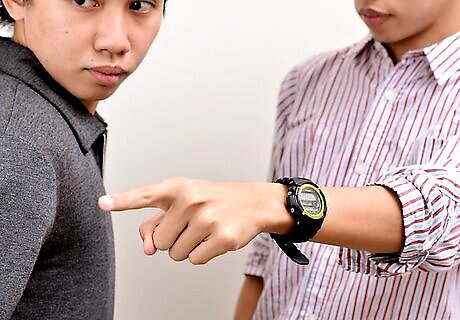
views

Point. If the third party is in the room or nearby, you can point directly to that person to show your conversation partner the person to whom you wish to refer. If they're not in the room, then just point to the left or right. Usually, you point to your dominant side first (and always point with your dominant signing hand). If you've already established a person on that side, point to the other side instead.

Name or describe the person the first time they're mentioned. In ASL, it's natural to first establish a person in the signing space, and then you can just point to that side until you decide to "put" someone else there. For example, you might sign MY BROTHER [point right] to start a sentence. Now you can just point to the right every time you want to say something about your brother. If you know a person's name, go ahead describe them (my brother, my friend, etc.) and point to their location in the signing space, then sign NAME and spell out their name. If they have a name sign, give that after spelling, and point again to reinforce that that person will be to the right (or left). You also may want to add additional information about that person when you first establish them. For example, MY COWORKER [point right] NAME J-A-N-E-T [name sign] [point right] LOUD, ANNOYING. You can then tell a story about what that person did, and your conversation partner will have a clear picture in their mind.

Once you've established a person, use classifiers to talk about them. After you establish a third party in the signing space, you can represent them with a classifier. People are shown using a "1" classifier (index finger upright) or if you want to show walking, kneeling, falling down, etc. you can use an upside down V classifier. For example, instead of signing word for word "My sister was running around and fell down on her knees, so I hurried over to her," you would establish your sister on one hand, yourself on the other, and then "run" two fingers around the signing space, have them "fall down" into a bent "kneeling position" while you make an expression of pain, and then have the "you" hand run over to the kneeling hand.

Use directional verbs to show actions of the third party. In addition to classifiers, you can also incorporate a third party into many ASL verbs. For example, to sign "Michael asked me," you'd point to the right, spell Michael, then bend your finger for the verb "ask" from the right side of your body, pointing towards you.

Turn your head and use your eyes to indicate movement or speech from/to the third party. In the previous example, you might want to ask the question "as" Michael. To do this, you'd turn your head left (remember, Michael is on your right side) and maybe look a bit down if Michael is taller than you. You would use facial expressions to take on Michael's personality, as well. You could then do a whole dialogue by turning from side to side, because you've established who's who. You can use your eyes in a similar way. If Michael is walking past you, you could use the "1" classifier to move Michael across your body and then follow that finger with your eyes.

Use your counting fingers to show multiple third parties at one time. It's difficult to show more than 2 to 3 individuals in the signing space at a time, but if you're talking about a group of five or fewer people, you can improvise with your counting fingers. Use the non-dominant hand to form a number, rotated to the side so that the fingertips are pointing towards your other hand and your palm is facing your chest. Indicate the subject first. For example, you might sign "I have three sisters," then hold up your rotated three hand. Point to each finger in turn to describe the people. Each person will reside in a particular finger, and that won't change. So you might point to the thumb, sign a name, an age, adjectives, etc., then hold up your three again and do the same with the index and middle. The thumb now represents the person you described after pointing to the thumb. Use this system to talk about one, some, or all of the people described. For example, if all your sisters are nice, you can sign "nice," then sweep your finger over all three fingertips. You could also sign nice, then use your thumb and index finger of the other hand to point to thumb and middle of your "three," indicating that only the first and the third sister you described are nice.




















Comments
0 comment